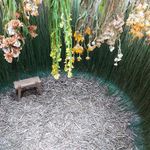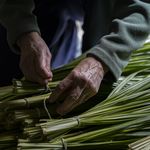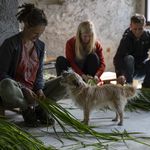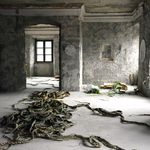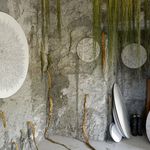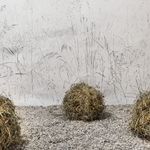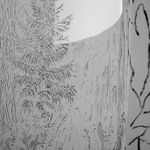UGM Studio / Mateja Kavčič

Mateja Kavčič / Sanctuary
UGM Studio, Trg Leona Štuklja 2
19 June – 14 August 2021
curator: Andreja Borin, museum counsellor
Since her graduation from the academy (1994), to this day painter Mateja Kavčič paved her unique creative path which has always been closely connected to nature — she installed her first exhibition project in Ljubljana's Tivoli Park (1997) instead of a gallery space. Later, she began painting round paintings with radially arranged tree leaves, depicting individual leaves of trees as if portraying most valuable individuals. Gradually, she crossed the boundaries of painting and began to create with nature in situ, while she finally physically transferred all these experiences to the gallery space. In 2016, she set up a comprehensive site-specific installation titled Shelters in the lapidary of the Božidar Jakac Gallery in Kostanjevica na Krki. In this exhibition the observer was offered various shelters made of grass, hay, sand, flowers, and creative imagination. However, these hideouts were not only designed for people, but for all beings and notions who had lost their place of refuge while civilisation evolved: myths, symbolism, silence, the holiness of nature, the natural rhythm of time, the subtle beings of nature, the human need for natural shelter, etc.
We live in a new geological epoch: the Anthropocene, in which human activity is changing the appearance of the Earth more strongly than all natural processes together. By cutting down forests and building roads and cities, we have transformed half of the ice-free land on Earth — and we have also fatally altered half of what remains. Ploughs and bulldozers move around more earth than all the world's rivers and streams. "People now outweigh wild mammals by a ratio of 8 to 1. Add in our domesticated animals (mostly cows and pigs), and the ratio is almost 23 to 1."* Concreting the planet, an overabundance of plastic, and mass extinction of plant and animal species also marked the Anthropocene. There is sufficient evidence of a disastrous course of developments at every turn. So where to find shelter or refuge in today's world? What is the role of art in this? How to connect simply and intimately with nature?
Mateja Kavčič incorporates these and similar questions into her spatial installations. She designed a round natural refuge reminiscent of human primary shelters from the beginning of time in the lower room of the UGM Studio. I imagine that the visitors will forget about the gallery environment, their errands, and time for a moment and simply indulge in the smell of grass, through the touch of natural materials, and feel the desire to be calm for a moment. I further imagine that the children will explore every inch of the installation and be thrilled with it.
With her paintings, drawings, and graphic prints, Mateja Kavčič communicates that each tree or blade of grass is valuable and that it is part of the whole. She belongs to those artists who express themselves for their own sake and not for the art market or current art trends. She invites us to a different experience and reminds us that on our glorious path of progress, people have (perhaps) lost something extremely valuable.
Mateja Kavčič was born 1970 in Novo mesto. After graduating from the Ljubljana High School of Design and Photography, in 1989 she enrolled in the painting department of the Academy of Fine Arts in Ljubljana, where she graduated in 1994 and attended a specialist postgraduate programme in painting in the following year. In 2007, she obtained a pedagogical and andragogical education at the Faculty of Arts, University of Ljubljana. Since 1995, she has been working as a freelancer in the cultural sector. She is a visual artist in the fields of painting, drawing, printmaking, photography, spatial installations, and land art. She participates in restoration projects and runs creative workshops for children. She has been living and creating in Škofja Loka for the past 18 years.
*Elizabeth Kolbert, "Why call recent disasters 'natural', when they really aren't", National Geographic Magazine, March 2021 issue, www.nationalgeographic.com/magazine/article/why-call-recent-disasters-natural-when-they-really-are-not.
The exhibition is part of the accompanying programme of the EKO 8, International Triennial of Art and Environment.
